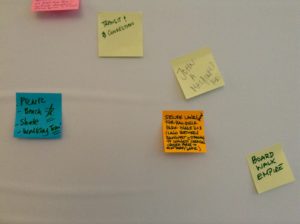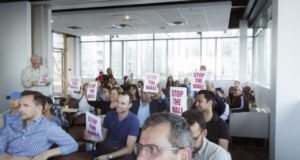If the fate the of the Rail Deck Park was to be decided by the approximately 150 people who turned up on June 14 at Metro Hall for the public consultation on this heroic effort by the city to create a 21-acre park in the west Downtown, the answer would be a unanimous “Yes!”
After hearing from city planners Lynda MacDonald and Anne-Marie Nasr as well as Urban Strategies’ Joe Berridge, attendees were well-versed in not only the planning process and preliminary findings of this visionary park but also the history behind Toronto’s Downtown boom, and most of all the need, amidst all of the core’s concrete and steel, for a people’s park.
The most pressing point made by all the presenters: the city’s dynamic growth. In 1994 (at the time when the city was contemplating its new urban vision) 6,700 residential units were anticipated for the Downtown area to house approximately 20,390 people—two times more than had been planned.
One slide in particular dropped jaws: the one that showed not only current condo developments but also those proposed for the not-to-distant future. Given all this, Berridge’s simple statement that “parks have not kept pace with growth” seemed not only a truth but an understatement.
Of course, Downtown has parks. But many are smaller than a half acre. And the urban parks we love to inhabit—such as Trinity Bellwoods and Canoe Landing—are well-used and packed on summer days.
The Rail Deck would not only be a park but would also act as a connecting corridor—a green space linking many of Downtown’s
other green and public spaces like the new Bentway, the two Stanley parks, the two new parks that will play host to the Garrison Crossing bridge nd Garrison Common itself along with the new Mouth of the Garrison park below Fort York library. In effect, the Rail Deck, as Burridge indicated, would create “a green walk from Union station to the CNE.”
In the modern world of parks, the Rail Deck is not without precedent. For all those who believe building a park over the rails—with all the engineering and structural challenges that implies—to be reckless and impossible, there are lessons to be learned from this century’s newest and most iconic parks. Most notably the Rives de Seine in Paris, located on the right bank of the Seine, turned an expressway into a 10-hectare multi-use park which attracts about four million visitors a year. Likewise, Rose Fitzgerald Kennedy Greenway in Boston is a 17-acre park built above a highway. A destination place, it attracts in excess of a million visitors a year. In Chicago the Millennium Park sits on top of a parking garage and commuter rail: this vast 16-acre mixed use public realm is largely regarded as being the world’s largest rooftop garden. It is regarded as the top tourist attraction in the USA and attracts 25 million visitors annually.
Due to lack of space within most city cores the need for adaptive use of current or redundant infrastructure is becoming increasingly necessary—and increasingly clever. A case in point: a conversation with planner Lynda MacDonald revealed she had recently visited the virtual layer cake of engineering that is Hudson Yards in Manhattan: 14 acres of gardens, plazas, and public space built over active railway and connecting the High Line, River Park and Hudson Park and Boulevard. More than inspiration, the Hudson Yards are proof that the Rail Deck is achievable.
After the presentation, participating residents were tasked to answer four key questions from the Table Discussion Guide.
- What are some of the best neighbourhood assets around the site? What is missing or could be improved?
- Do you agree with council’s direction to update the official plan to support a park over the rail corridor? Why or why not?
- What principles and objectives should guide the future use of the site? And
- Is there anything else the city should consider when planning for the future use of the site?
With 15 minutes to answer each question and with five or six people around each table, the discussions were animated and even passionate. Members of the city planning, parks, recreation and forestry staffs were on hand as were members of the Urban Strategies Inc. team.
At the meeting’s end a spokesperson for each discussion table had the opportunity to share their findings. To sum the responses up: it would be a people’s park with activities and programming for all ages; it would provide shade, be sustainable and be accessible; it would be a connector, and a place to play and have team games and concerts; it would be a place for dogs and wildlife; it would be a tourist destination and a place for art and culture; it would play host to native plantings, and use natural materials; it would be animated and would be a place to gather and of celebrate; it would be enjoyed by locals from surrounding neighbourhoods and it would be a magnet for tourists in a city that underperforms with its attractions. With every comment came a strong takeaway: the real and positive need for the park.
So how will the project be funded? It has been indicated that some $350 million at least could possibly come from the Section 42 fund (a cash-for-parks levy on certain developments) but the approval of the project is the priority over financing it.
The final planning report is scheduled to go to council in late fall or winter.
With public support growing, the Rail Deck Park planning team seems to be parking up the right tree.
- Peter Margolian, a cyclist and park goer and Queen/River resident supports the need for a Downtown park.
- Counting the red dots: “We say yeah!”
- Alex Beheshti—a John St. resident—would like to see a park that enhances people’s lives featuring multi-variant uses: festivals, turf, baseball diamonds, farmers’ markets.
- Working through the benefits and issues of the park with staff from Planning, Forestry and Recreation on hand.
- Attendees were invited to write comments on Stickies.
- Planner Lynda Macdonald starts the meeting off with a look at the Official Plan Land Use.
- Discussion materials and workbook.
- City Planner Lynda MacDonald.
 TheBulletin.ca Journal of Downtown Toronto
TheBulletin.ca Journal of Downtown Toronto










